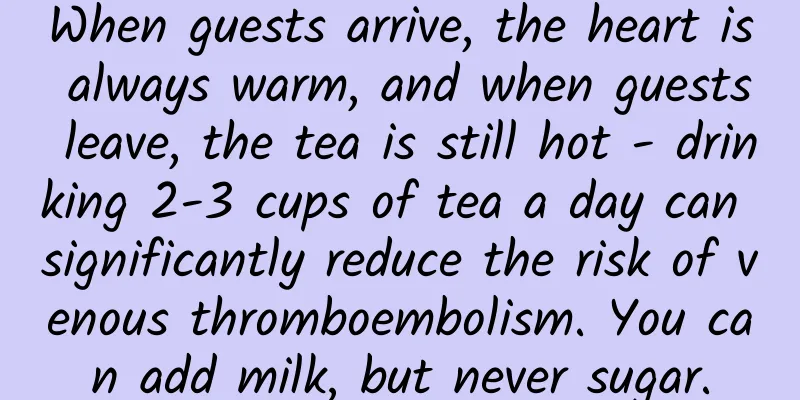When guests arrive, the heart is always warm, and when guests leave, the tea is still hot - drinking 2-3 cups of tea a day can significantly reduce the risk of venous thromboembolism. You can add milk, but never sugar.

|
Venous thromboembolism (VTE), including deep vein thrombosis (DVT) and pulmonary embolism (PE), is the third most common vascular disease after acute myocardial infarction and stroke, with approximately 10 million new cases of VTE each year worldwide. Therefore, identifying more modifiable risk factors and strengthening primary prevention of VTE have important clinical and public health value. Tea is one of the most widely consumed beverages in the world. Tea is rich in polyphenols, which have been shown to have potential anti-obesity, antioxidant, anti-inflammatory and platelet aggregation inhibitory properties. However, the association between tea drinking and the risk of VTE is still unclear. In addition, many tea drinkers are accustomed to adding milk or sweeteners to tea, and the use of these additives may affect the potential benefits of bioactive substances in tea. Therefore, it is necessary to further evaluate whether the use of additives affects the association between tea drinking and the risk of VTE. (Pictures from the Internet, copyright belongs to the original author) In response to the above clinical problems, a recent study published in the journal Thrombosis and Haemostasis found that drinking tea without sweeteners, regardless of whether milk is added, can significantly reduce the risk of VTE, but drinking tea with sweeteners has no significant effect on the risk of VTE. Professor Qin Xianhui of the National Clinical Research Center for Kidney Diseases, Nanfang Hospital, Southern Medical University is the corresponding author of the article, and master's student Xiang Hao is the first author. The study included more than 190,000 middle-aged and elderly participants who did not have VTE at baseline and completed at least one 24-hour dietary recall survey. 82.6% of the participants drank tea regularly, of which 14.1%, 51.8%, 1.7% and 15.0% reported drinking tea without milk and sweeteners, only milk, only sweeteners and both milk and sweeteners, respectively. During the 12.1-year follow-up, 4485 (2.4%) participants developed VTE. Compared with participants who did not drink tea, participants who drank tea without milk and sweeteners, tea with only milk, and tea with both milk and sweeteners had significantly lower risks of VTE by 15%, 14%, and 10%, respectively; however, drinking tea with only sweeteners was not significantly associated with the risk of VTE (Figure 1). Figure 1. Association between drinking tea with different additives and the risk of VTE Further evaluation of the association between tea intake and VTE risk showed that tea intake was L-shapedly associated with VTE risk among tea drinkers who drank tea without milk and sweeteners (Figure 2A), only added milk (Figure 2B), and added both milk and sweeteners (Figure 2C), with the lowest risk of VTE among those who drank 2-3 cups of tea. However, among tea drinkers who only added sweeteners to their tea, there was no significant association between tea intake and VTE risk (Figure 2D). Figure 2. Dose-response relationship between tea intake and risk of VTE in tea drinkers with different tea additives This large prospective study showed that** drinking unsweetened tea, with or without added milk, was associated with a significantly lower risk of VTE, whereas drinking tea with only added sweeteners was not significantly associated with VTE risk.** Given that tea is the second most consumed beverage after water, even a small benefit on VTE could have a large public health impact. Drinking unsweetened tea can be part of a healthy diet and may be a relatively simple, inexpensive, and safe strategy to prevent VTE. (Pictures from the Internet, copyright belongs to the original author) Tea has only two postures, floating and sinking; tea drinkers have only two postures, picking up and putting down. Time is just like the fresh rain, and I am leisurely drinking a pot of tea. I prefer tea that is light but has flavor, and a cup of clear tea makes the feelings more real. References: Xiang H, Liu M, Zhou C, Huang Y, Zhang Y, He P, Ye Z, Yang S, Zhang Y, Gan X, Qin X. Tea Consumption, Milk or Sweeteners Addition, Genetic Variation in Caffeine Metabolism, and Incident Venous Thromboembolism. Thromb Haemost . 2024 May 10. doi: 10.1055/s-0044-1786819IF:6.7 Q1. Editor: Xiang Hao Reviewer: Qin Xianhui |
<<: Man dies of sudden cardiac death after taking painkillers, revealing heart health crisis
>>: AI robot chemist: new hope for future cancer treatment
Recommend
The Time and You Are Very Sweet is based on what? Where can I read the novel The Time and You Are Very Sweet?
In recent years, campus youth idol dramas have be...
How do dialysis patients avoid infection? You must know these 5 protective measures!
Dialysis patients are more vulnerable to infectio...
What to do if the cervix is tilted to the left
Female friends all know that their bodies are str...
What does an enlarged uterus mean?
During the examination, women often find that it ...
How to take care of your private parts
Nowadays, most people have very conservative idea...
Danger! Beware of these 4 conditions that may occur to your parents after COVID-19
On the first day after infection, there may be no...
Cervical cauliflower
The female uterus is a very important organ for w...
Can pregnant women eat eels? Can pregnant women eat eels?
Eel is a good thing. It is not only rich in fat, ...
Ovarian pain during ovulation
It is a normal physiological reaction for female ...
Can applying pearl powder, lemon, cucumber, etc. on the face whiten your skin? Beware of "bad face"! The correct whitening method is...
Author: Meng Yao, Ph.D., Doctor of Medicine, Zhon...
What are the breast enhancement techniques?
Every woman hopes to have a plump chest. Having p...
What should women with qi and blood deficiency eat?
Women lack qi and blood, and the phenomenon of qi...
Can I sleep with my partner during menstruation?
Menstruation is a physiological phenomenon of wom...
Causes of frequent urination during early pregnancy
Many female friends have low immunity after pregn...
Why does my lower abdomen hurt occasionally 24 days after giving birth?
After 24 days after delivery, if you occasionally...









